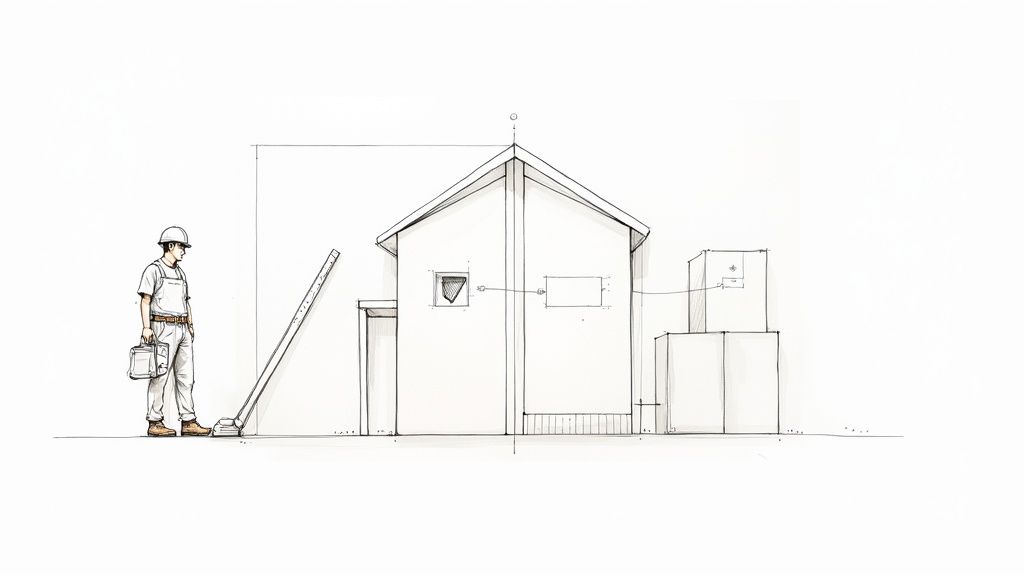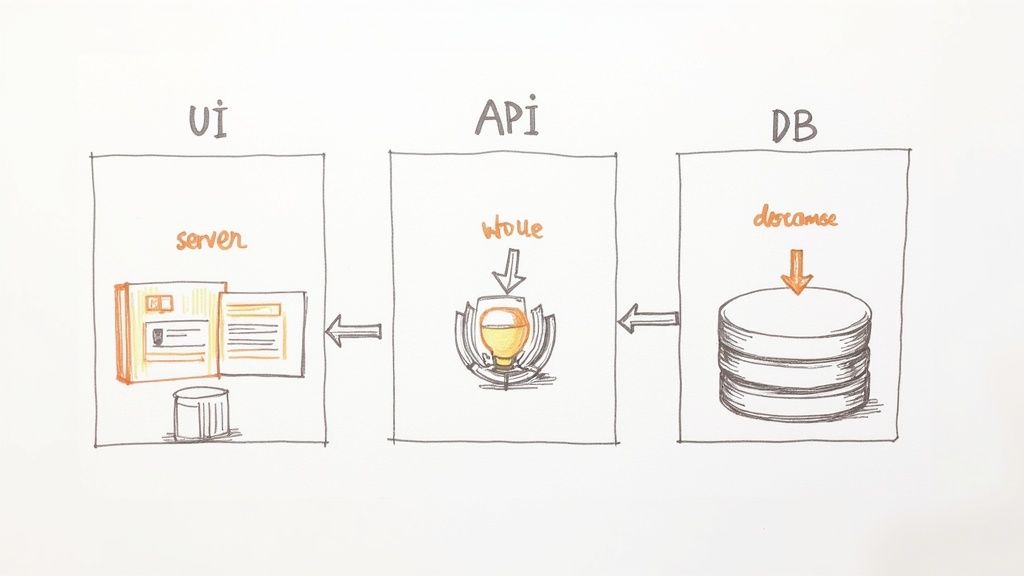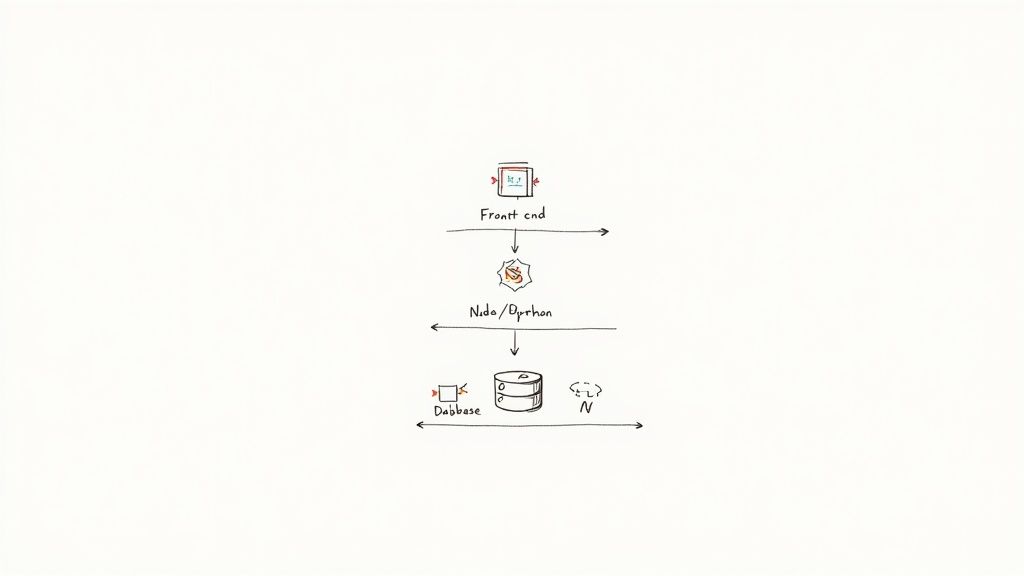Crafting the Perfect Full Stack Developer Job Description
Max
When you post a job for a full stack developer, you’re not just looking for a coder. You’re searching for someone who can work on both the front-end (what users see) and the back-end (the server, database, and logic behind the scenes). Essentially, you need a versatile pro who can build a complete web application from the ground up.
What a Full Stack Developer Really Does

Before you even think about writing the job description, you have to get your head around what this role truly involves. Forget the dry definitions. Think of a full stack developer as the master builder of a house—they don’t just handle the drywall; they oversee the entire project from foundation to finish.
This builder is responsible for laying the foundation and hooking up the complex plumbing and electrical systems. In the tech world, that’s the back-end development. It’s all the heavy lifting that happens on the server—the databases, the application logic, the APIs—that users never see but rely on completely.
But they don’t stop there. They also design the interior, pick out the paint colors, and install the fixtures. That’s the front-end development. This is everything the user clicks, sees, and interacts with, built using technologies like HTML, CSS, and JavaScript.
The Value of Versatility
This dual skill set is their superpower. A true full stack developer understands how the front-end and back-end need to talk to each other to create a cohesive experience. This kind of versatility is gold, especially on agile teams where moving fast and collaborating effectively is everything.
Instead of waiting for the back-end team to finish their part before the front-end team can start, a full stack developer can jump in and solve problems across the entire technology stack. This autonomy speeds up everything and leads to a much more integrated and polished final product.
A full stack developer’s value isn’t just in knowing multiple languages; it’s in understanding how the front-end and back-end communicate to create a complete, functional system. They see the entire blueprint, not just one room.
Why This Matters for Your Job Description
Grasping this complete picture is your first step to writing a full stack developer job description that actually attracts the right people. Your goal is to find candidates who get excited about this kind of end-to-end ownership.
A great job post will connect with developers who are:
- Problem-Solvers: They love the challenge of chasing a bug, whether it’s hiding in the database or showing up in the UI.
- Project-Oriented: They get a real sense of satisfaction from taking a project from a rough idea all the way to deployment.
- Collaborative Communicators: They can translate between designers and database architects, bridging the gap and keeping everyone on the same page.
When you frame the role like a “master builder,” you elevate it beyond a simple checklist of technical skills. You start telling a story about a position that offers real impact and ownership—and that’s exactly what the best developers are searching for.
Defining Core Responsibilities And Expectations

To land the right person, your job description has to be more than just a laundry list of tasks. It needs to paint a clear picture of what the day-to-day work actually looks like, setting the right expectations from the get-go. A full stack developer’s world covers the entire software development lifecycle, from the initial “what if?” conversations all the way to post-launch support.
You can think of their work as having three main domains. While each area requires its own unique skills, the real magic happens when they weave all three together into a single, seamless product.
Client-Side Development
This is the front-end—everything the user sees, clicks, and interacts with. The developer’s job here is to take UI/UX designs and turn them into intuitive, responsive, and accessible interfaces that just work.
- Building user interfaces: They write clean, modern code using staples like HTML, CSS, and JavaScript.
- Implementing frameworks: They bring the interface to life with frameworks like React, Angular, or Vue.js to create dynamic experiences.
- Ensuring responsiveness: The final product has to look and feel great on any device, whether it’s a huge desktop monitor or a tiny smartphone screen.
Server-Side Architecture
Now we’re in the back-end, the engine room that powers the whole application. Here, the developer builds the server, application logic, and APIs that handle all the heavy lifting and data processing. The focus shifts to creating a system that’s secure, scalable, and efficient.
The core of a full stack developer’s responsibility is not just building features but architecting the entire system. They must ensure the server logic is robust enough to support the user interface and that data flows seamlessly between them.
This end-to-end perspective is precisely what makes them so valuable. If you want to dig deeper into how these roles fit into the bigger picture, this comprehensive guide to jobs in software engineering is a fantastic resource.
Database And Lifecycle Management
Finally, someone has to manage the data. This means designing and maintaining the databases that store all the application’s information safely and efficiently. They’ll be the ones choosing the right database technology—SQL or NoSQL—and fine-tuning it for top performance.
But their job doesn’t stop when the code is written. They are plugged into the entire project lifecycle, which includes:
- Conceptualization: Being in the room for the initial brainstorming and planning sessions.
- Coding and Review: Writing solid, high-quality code and giving constructive feedback in peer reviews. We have a great guide on code review best practices that shows how this builds a strong development culture.
- Deployment: Using CI/CD pipelines to push code into production.
- Maintenance: Jumping in to troubleshoot and squash bugs after the application is live.
To give you a clearer snapshot, here’s a breakdown of their primary responsibilities across the stack.
Full Stack Developer Key Responsibility Areas
| Area of Responsibility | Key Activities | Example Technologies |
|---|---|---|
| Front-End Development | Crafting UIs, ensuring cross-browser compatibility, and optimizing for performance. | HTML, CSS, JavaScript, React, Vue.js, Angular |
| Back-End Development | Building server-side logic, developing APIs, and managing server infrastructure. | Node.js, Python, Ruby on Rails, Express.js |
| Database Management | Designing schemas, managing data storage, and optimizing database queries. | MySQL, PostgreSQL, MongoDB, Redis |
| DevOps & Lifecycle | Implementing CI/CD pipelines, managing deployments, and maintaining code quality. | Git, Docker, Jenkins, AWS, Azure |
This table helps illustrate just how broad their involvement is. They truly are the glue that holds a project together from start to finish.
This wide-ranging skillset is why the role is so critical. The U.S. Bureau of Labor Statistics projects a 16% employment growth for web developers between 2022 and 2032, a rate blowing past the average for all other jobs.
Listing the Essential Skills and Technologies

A powerful full stack developer job description goes way beyond listing vague responsibilities. It gets specific about the tools of the trade. Think of it like a recipe: you wouldn’t just list “flour”; you’d specify all-purpose or whole wheat. That same level of precision is exactly what you need when you’re outlining the technical skills for the role.
Breaking down your requirements by function—front-end, back-end, and database—brings immediate clarity. It helps candidates quickly see if their skills match your stack and stops your job post from turning into an intimidating wall of buzzwords.
Front-End Foundations
This is the user-facing side of the stack, where developers build everything people see and click on. Your job description has to be crystal clear about which frameworks are the core of your projects.
- Core Languages: Proficiency in HTML, CSS, and JavaScript is the absolute, non-negotiable bedrock of front-end development. Every developer in this space needs to know them inside and out.
- Modern Frameworks: This is where you get specific. Are you a React, Angular, or Vue.js shop? These tools aren’t interchangeable, so being upfront is critical. A developer with deep React experience, for instance, probably isn’t the right fit for a team that lives and breathes Angular.
Back-End and Database Expertise
If the front-end is the car’s dashboard, the back-end is the engine room—it handles all the server logic, data crunching, and heavy lifting. Nailing this section ensures you attract candidates who can build and maintain a system that’s both scalable and secure.
- Server-Side Languages: Name your primary back-end language, whether it’s Node.js, Python, Java, or PHP. Different languages are built for different jobs, and you can explore some of the best programming languages to learn to get a feel for their unique strengths.
- Database Systems: It’s important to distinguish between SQL databases (like PostgreSQL or MySQL) and NoSQL databases (like MongoDB). Mentioning your specific system helps filter for candidates who already have relevant data modeling experience.
Separating your tech needs into “must-haves” and “nice-to-haves” is a simple but incredibly effective strategy. It keeps your core requirements locked in while opening the door to promising candidates who can pick up the peripheral technologies on the job.
The Overlooked Essential: Soft Skills
Technical fluency is only half the battle. A developer who can’t communicate or collaborate is a bottleneck, no matter how brilliant their code is. In fact, most high-performing teams will tell you their success comes just as much from strong interpersonal skills as it does from technical chops.
Your job description needs to call these out directly. These aren’t just fluffy add-ons; they’re core competencies that make or break a team.
- Collaborative Problem-Solving: Frame this as the ability to jump on a call with designers, product managers, and other engineers to hash out the best path forward.
- Clear Communication: Emphasize the need to explain complex technical ideas to non-technical folks without making their eyes glaze over.
- Adaptability: The best full stack developers can pivot. Mention the ability to switch between different parts of the tech stack and get up to speed on new tools as projects evolve.
By detailing both the hard and soft skills, your full stack developer job description will do more than just attract coders—it will attract well-rounded professionals who can build great software and be great teammates.
Your Customizable Job Description Template
Alright, let’s move from theory to action. What follows is a solid, ready-to-use template for your next full stack developer job description. Think of it as a starting point—you’ll want to tweak it to reflect your company’s unique vibe, tech stack, and the specific challenges of the role.
The real goal here is to do more than just list a bunch of requirements. A great job description tells a story. It should paint a picture of the opportunity and make the right kind of developer genuinely excited to join your team.
Job Title
First things first: be specific. A generic title like “Developer” gets lost in the noise.
- Good: Full Stack Developer
- Better: Full Stack Developer (React & Node.js)
- Best: Senior Full Stack Engineer (Python/Django)
This simple change helps your listing pop up in the right searches and immediately lets candidates know if their core skills are a match.
Company Overview
This is your elevator pitch. Don’t just regurgitate your “About Us” page. Talk about your mission. What problem are you trying to solve, and why should a top-tier developer care?
Example: “At [Company Name], we’re not just building [Product]; we’re on a mission to [Your Mission]. Our team is driven by a passion for solving complex problems, and we believe that [Company Value] is the key to our success. We’ve created a culture where innovation thrives, and every team member has a direct impact on our journey.”
What You Will Achieve
Let’s ditch the boring “Responsibilities” list and frame it as “What You’ll Achieve.” This simple shift changes the focus from a list of chores to a sense of impact and ownership. It’s way more compelling.
- Design and build scalable, secure, and maintainable applications from end to end.
- Collaborate with cross-functional teams, including product managers and designers, to translate ideas into functional user experiences.
- Architect and implement robust back-end services and APIs that power our user-facing features.
- Write clean, high-quality code and mentor junior developers through constructive code reviews.
- Own features throughout the entire software development lifecycle, from concept to deployment and maintenance.
The market for software engineers is exploding, with a projected 17% increase in roles over the next decade. That’s about 327,900 new positions. In a market this hot, employers are looking past formal degrees and focusing on practical skills and strong portfolios. With nearly 87% of developers wanting remote or hybrid work, crafting a job description that sells the impact and flexibility of the role is absolutely essential.
Required Skills And Qualifications
Be crystal clear here. Splitting your requirements into two lists—”Must-Haves” and “Nice-to-Haves”—can dramatically widen your talent pool.
Must-Haves:
- 3-5 years of hands-on experience in full stack development.
- Proficiency in our core stack: [Your Front-End Tech, e.g., React], [Your Back-End Tech, e.g., Node.js], and [Your Database, e.g., PostgreSQL].
- A solid grasp of API design and development (RESTful, GraphQL).
- Experience with cloud platforms like [e.g., AWS, Azure].
Nice-to-Haves:
- Familiarity with containerization tools like Docker.
- Experience with CI/CD pipelines.
- Knowledge of [Secondary Technology, e.g., TypeScript].
To take this template from good to great, it’s worth checking out expert advice on writing a job description that actually attracts top talent. And if you want to go even deeper, our own guide on how to write job descriptions is packed with more detailed strategies.
Tailoring Your Listing for Remote and Hybrid Work

In a world where top talent can work from anywhere, a generic job description just won’t cut it anymore. If you want to attract skilled remote or hybrid full stack developers, you have to prove you’re not just tolerant of remote work—you’re built for it.
This means being upfront about what working with your team actually looks like. A one-size-fits-all listing leaves experienced remote candidates with too many unanswered questions. They need to know how your team collaborates, communicates, and stays connected without sharing an office. Being transparent from the get-go is a massive signal that you’re serious about supporting a distributed team.
Communicating Your Remote-First Culture
Your job description needs to spell out your company’s approach to remote work. Are you fully distributed? Hybrid? Remote-friendly with a few strings attached? Don’t make candidates guess.
Proactively addressing your remote work policies shows respect for a candidate’s time and priorities. It proves you understand that for many developers, the “where” and “how” of their work are just as important as the “what.”
Clarity is everything. Outline the practical, day-to-day elements that define your remote culture. This isn’t just about perks; it’s about the operational backbone that makes distributed work click. For a deeper dive, check out this excellent guide on hiring remote developers.
Outlining Your Virtual Collaboration Stack
Every remote team runs on a specific set of tools. Listing yours gives candidates a concrete picture of your daily workflow and shows you’ve got a real process for virtual collaboration.
- Communication Hub: Mention your go-to tools like Slack or Microsoft Teams for daily check-ins and quick chats.
- Project Management: Specify your system, whether it’s Jira, Asana, or Trello. This shows how you track tasks and measure progress.
- Creative Collaboration: Include tools like Miro or Figma if they are a core part of your design and brainstorming sessions.
Getting this specific helps you connect with self-starters who are already pros with these tools and thrive in a well-organized remote setup.
Setting Clear Expectations
Finally, get down to the logistics. Time zone alignment is a classic pain point for distributed teams, so be clear about what you need.
- Time Zone Alignment: State whether developers need to have significant overlap with a specific time zone, like EST or PST.
- Meeting Cadence: Give a quick rundown of your meeting culture. Do you have a daily stand-up? Are most meetings optional?
- Flexibility: Highlight the level of autonomy developers have over their schedules.
This proactive approach ensures a much better fit for everyone involved. It helps filter for candidates who aren’t just skilled, but are also perfectly wired for your company’s unique way of working.
Common Questions About Hiring Full Stack Developers
Even with the perfect job description ready to go, you’re bound to have some lingering questions about hiring a full stack developer. Let’s tackle some of the most common ones that come up so you can move forward with confidence.
What Is a Realistic Salary Range?
Figuring out the right compensation is often the trickiest part. What you’ll pay a full stack developer can swing wildly based on their experience, your location, and the specific tech they’ll be working with.
Here’s a general ballpark to get you started:
- Junior (1-3 years): You’re likely looking at a range of $90,000 to $110,000. These developers are fantastic for getting foundational tasks done, but they’ll definitely need some mentorship to grow.
- Mid-level (3-5 years): Expect to offer something between $110,000 to $140,000. At this stage, they can take on complex projects and see them through with much more independence.
- Senior (5+ years): Salaries here usually start at $140,000 and can climb much higher. These are the folks who lead projects, mentor junior devs, and can architect entire systems from the ground up.
Remember to always check out the benchmarks for your local market or for remote roles. A competitive offer is your best bet for grabbing the attention of top talent.
How Do You Differentiate Experience Levels?
Telling the difference between a junior, mid-level, and senior candidate isn’t just about years on the job—it’s about the scope of their impact and how much autonomy they can handle.
A junior developer writes code. A mid-level developer builds features. A senior developer architects solutions and owns outcomes.
You should frame your job requirements with this in mind. For a junior role, talk about learning and contributing to an existing codebase. For a mid-level position, focus on their ability to build and ship features independently. And for a senior role, you absolutely need to highlight strategic responsibilities like system design, technical leadership, and mentoring.
Should I Hire a Generalist or Two Specialists?
Ah, the classic dilemma. The truth is, the right answer depends entirely on where your team is at and what your project needs.
Hire a Full Stack Generalist if: You’re an early-stage startup trying to get a product from zero to one. A generalist is perfect for small, agile teams where being versatile is way more valuable than deep specialization. Their knack for quickly switching between the front-end and back-end can seriously speed things up.
Hire Two Specialists (Front-End & Back-End) if: You’re scaling a complex application that’s already established. Specialists bring a depth of expertise that can fine-tune performance, tighten security, and ensure your platform can handle growth. This is almost always the better call for larger teams that need that in-depth knowledge.
There’s no single right answer here, but this should give you a good framework for making the call. If you want to dive deeper into sourcing technical talent, our guide on hiring remote software developers has some great strategies.
Even though the hiring climate in some corners of the tech world feels a bit cautious, full stack developers are still incredibly vital. The game has changed, though. It’s less about academic credentials and more about proven skills in modern languages and cloud platforms. This means developers have to keep learning to stay sharp, which is great for you—it ensures they remain some of the most sought-after pros as companies everywhere continue their digital push. You can learn more about the competitive software job market on codesmith.io.
Ready to find your next great full stack developer? At Remote First Jobs, we connect you with verified, top-tier talent from around the world. Post your job today and reach skilled professionals ready to make an impact. https://remotefirstjobs.com


